Team Management: Building High-Performance Teams in Organizations
VerifiedAdded on 2023/06/15
|10
|1828
|434
Report
AI Summary
This report provides an overview of team management, focusing on the development of high-performing teams and the role of effective team leadership within organizations. It outlines the five stages of team development: forming, storming, norming, performing, and adjourning, and emphasizes the characteristics of high-performing teams, such as transparent communication, shared goals, and mutual trust. The report also highlights the crucial role of a team leader in motivating team members, resolving conflicts, and setting clear, achievable goals. Furthermore, it addresses the impact of teams on organizational performance, the challenges faced by virtual teams (including poor communication, differences in work ethic, time management issues, and lack of empathy), and the importance of utilizing different types of teams to achieve various organizational objectives. The report concludes by underscoring the direct relationship between high-performing teams and the effective accomplishment of organizational goals.
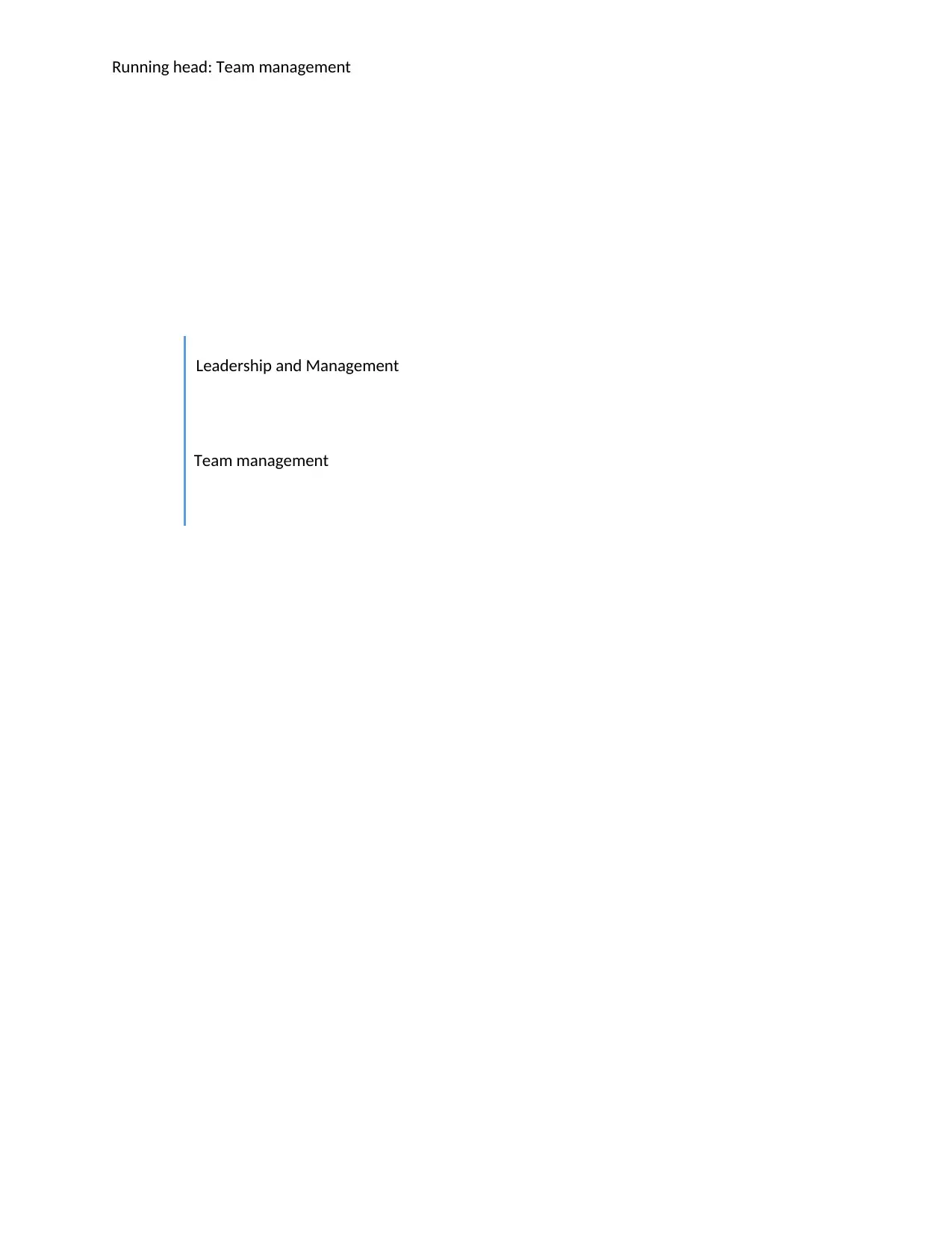
Running head: Team management
Leadership and Management
Team management
Leadership and Management
Team management
Paraphrase This Document
Need a fresh take? Get an instant paraphrase of this document with our AI Paraphraser

Team management 1
Contents
Introduction......................................................................................................................................1
Development of teams.....................................................................................................................1
Forming........................................................................................................................................1
Storming.......................................................................................................................................1
Norming.......................................................................................................................................1
Performing...................................................................................................................................2
Adjourning...................................................................................................................................2
Characteristics of high performing teams........................................................................................2
Transparent communication.........................................................................................................2
Same goal.....................................................................................................................................2
Trust among team-members.........................................................................................................2
Role of team leader in creating a high performance team...............................................................3
Leading by example.....................................................................................................................3
Motivation....................................................................................................................................3
Resolving conflicts.......................................................................................................................3
Contents
Introduction......................................................................................................................................1
Development of teams.....................................................................................................................1
Forming........................................................................................................................................1
Storming.......................................................................................................................................1
Norming.......................................................................................................................................1
Performing...................................................................................................................................2
Adjourning...................................................................................................................................2
Characteristics of high performing teams........................................................................................2
Transparent communication.........................................................................................................2
Same goal.....................................................................................................................................2
Trust among team-members.........................................................................................................2
Role of team leader in creating a high performance team...............................................................3
Leading by example.....................................................................................................................3
Motivation....................................................................................................................................3
Resolving conflicts.......................................................................................................................3

Team management 2
Goal Setting..................................................................................................................................3
Impact of team on organizational performance...............................................................................3
Challenges in performing virtual teams...........................................................................................4
Poor communication....................................................................................................................4
Differences in work ethic.............................................................................................................4
Time management........................................................................................................................4
Lack of empathy...........................................................................................................................4
Importance of using different kinds of teams..................................................................................4
Goal Setting..................................................................................................................................3
Impact of team on organizational performance...............................................................................3
Challenges in performing virtual teams...........................................................................................4
Poor communication....................................................................................................................4
Differences in work ethic.............................................................................................................4
Time management........................................................................................................................4
Lack of empathy...........................................................................................................................4
Importance of using different kinds of teams..................................................................................4
⊘ This is a preview!⊘
Do you want full access?
Subscribe today to unlock all pages.

Trusted by 1+ million students worldwide
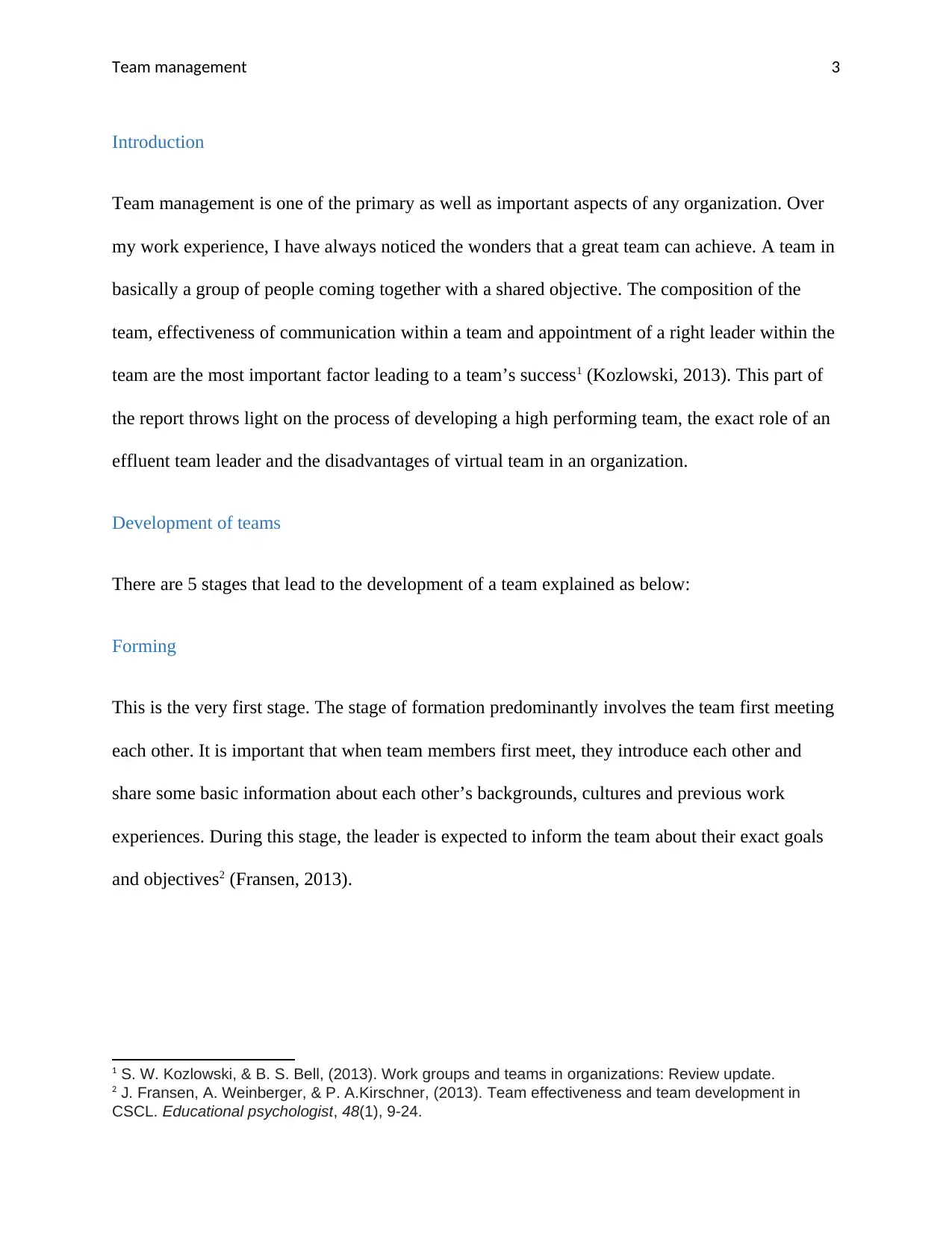
Team management 3
Introduction
Team management is one of the primary as well as important aspects of any organization. Over
my work experience, I have always noticed the wonders that a great team can achieve. A team in
basically a group of people coming together with a shared objective. The composition of the
team, effectiveness of communication within a team and appointment of a right leader within the
team are the most important factor leading to a team’s success1 (Kozlowski, 2013). This part of
the report throws light on the process of developing a high performing team, the exact role of an
effluent team leader and the disadvantages of virtual team in an organization.
Development of teams
There are 5 stages that lead to the development of a team explained as below:
Forming
This is the very first stage. The stage of formation predominantly involves the team first meeting
each other. It is important that when team members first meet, they introduce each other and
share some basic information about each other’s backgrounds, cultures and previous work
experiences. During this stage, the leader is expected to inform the team about their exact goals
and objectives2 (Fransen, 2013).
1 S. W. Kozlowski, & B. S. Bell, (2013). Work groups and teams in organizations: Review update.
2 J. Fransen, A. Weinberger, & P. A.Kirschner, (2013). Team effectiveness and team development in
CSCL. Educational psychologist, 48(1), 9-24.
Introduction
Team management is one of the primary as well as important aspects of any organization. Over
my work experience, I have always noticed the wonders that a great team can achieve. A team in
basically a group of people coming together with a shared objective. The composition of the
team, effectiveness of communication within a team and appointment of a right leader within the
team are the most important factor leading to a team’s success1 (Kozlowski, 2013). This part of
the report throws light on the process of developing a high performing team, the exact role of an
effluent team leader and the disadvantages of virtual team in an organization.
Development of teams
There are 5 stages that lead to the development of a team explained as below:
Forming
This is the very first stage. The stage of formation predominantly involves the team first meeting
each other. It is important that when team members first meet, they introduce each other and
share some basic information about each other’s backgrounds, cultures and previous work
experiences. During this stage, the leader is expected to inform the team about their exact goals
and objectives2 (Fransen, 2013).
1 S. W. Kozlowski, & B. S. Bell, (2013). Work groups and teams in organizations: Review update.
2 J. Fransen, A. Weinberger, & P. A.Kirschner, (2013). Team effectiveness and team development in
CSCL. Educational psychologist, 48(1), 9-24.
Paraphrase This Document
Need a fresh take? Get an instant paraphrase of this document with our AI Paraphraser
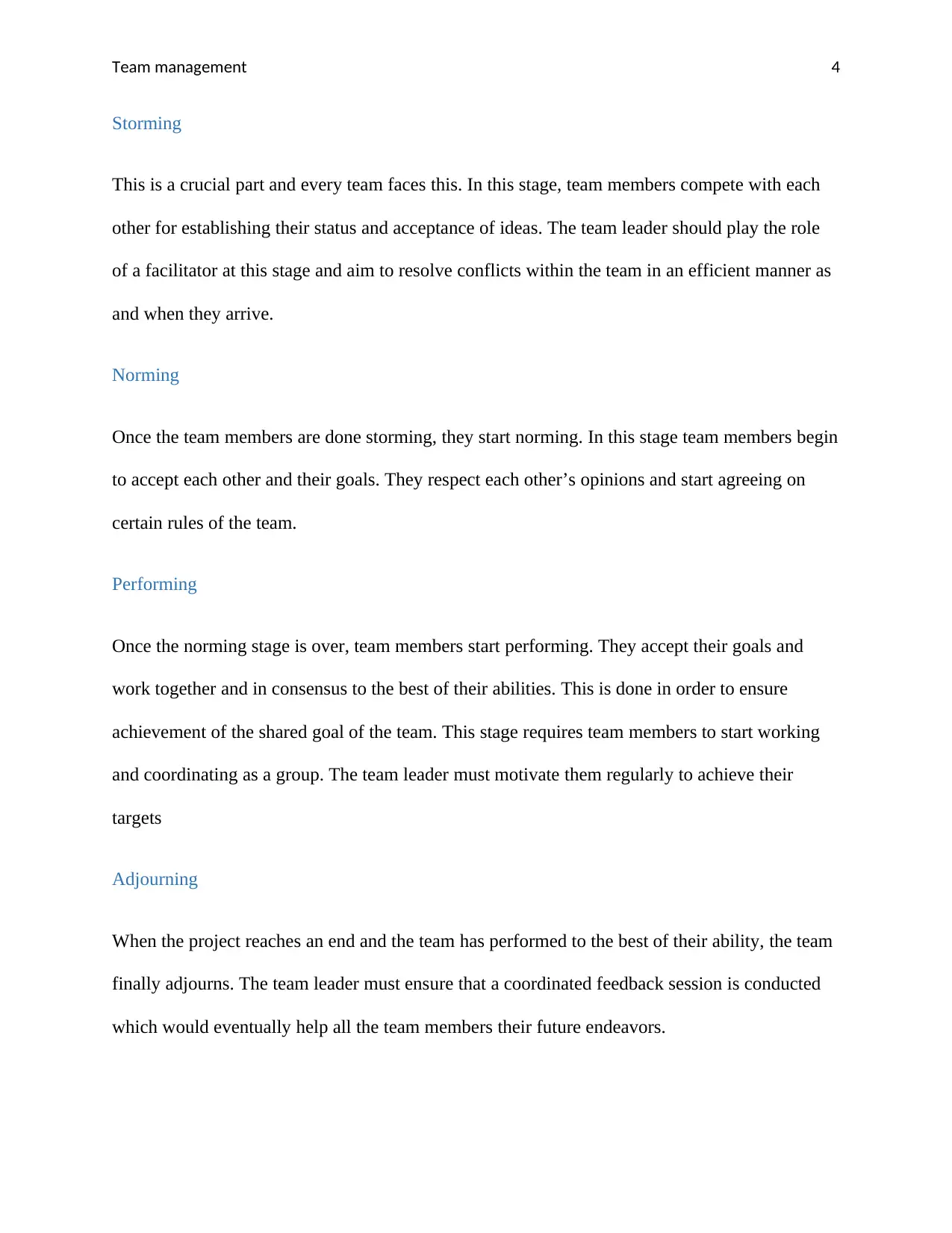
Team management 4
Storming
This is a crucial part and every team faces this. In this stage, team members compete with each
other for establishing their status and acceptance of ideas. The team leader should play the role
of a facilitator at this stage and aim to resolve conflicts within the team in an efficient manner as
and when they arrive.
Norming
Once the team members are done storming, they start norming. In this stage team members begin
to accept each other and their goals. They respect each other’s opinions and start agreeing on
certain rules of the team.
Performing
Once the norming stage is over, team members start performing. They accept their goals and
work together and in consensus to the best of their abilities. This is done in order to ensure
achievement of the shared goal of the team. This stage requires team members to start working
and coordinating as a group. The team leader must motivate them regularly to achieve their
targets
Adjourning
When the project reaches an end and the team has performed to the best of their ability, the team
finally adjourns. The team leader must ensure that a coordinated feedback session is conducted
which would eventually help all the team members their future endeavors.
Storming
This is a crucial part and every team faces this. In this stage, team members compete with each
other for establishing their status and acceptance of ideas. The team leader should play the role
of a facilitator at this stage and aim to resolve conflicts within the team in an efficient manner as
and when they arrive.
Norming
Once the team members are done storming, they start norming. In this stage team members begin
to accept each other and their goals. They respect each other’s opinions and start agreeing on
certain rules of the team.
Performing
Once the norming stage is over, team members start performing. They accept their goals and
work together and in consensus to the best of their abilities. This is done in order to ensure
achievement of the shared goal of the team. This stage requires team members to start working
and coordinating as a group. The team leader must motivate them regularly to achieve their
targets
Adjourning
When the project reaches an end and the team has performed to the best of their ability, the team
finally adjourns. The team leader must ensure that a coordinated feedback session is conducted
which would eventually help all the team members their future endeavors.
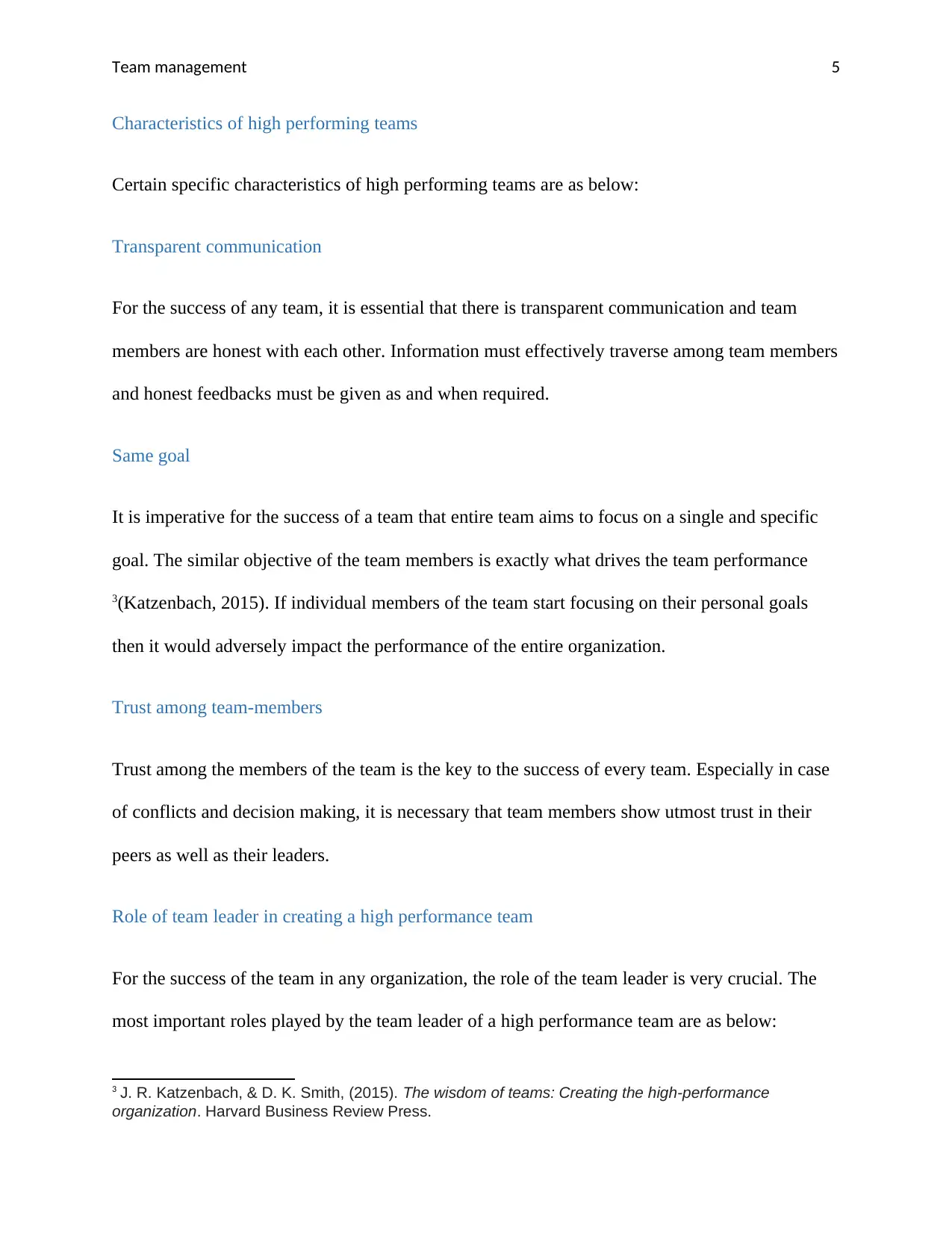
Team management 5
Characteristics of high performing teams
Certain specific characteristics of high performing teams are as below:
Transparent communication
For the success of any team, it is essential that there is transparent communication and team
members are honest with each other. Information must effectively traverse among team members
and honest feedbacks must be given as and when required.
Same goal
It is imperative for the success of a team that entire team aims to focus on a single and specific
goal. The similar objective of the team members is exactly what drives the team performance
3(Katzenbach, 2015). If individual members of the team start focusing on their personal goals
then it would adversely impact the performance of the entire organization.
Trust among team-members
Trust among the members of the team is the key to the success of every team. Especially in case
of conflicts and decision making, it is necessary that team members show utmost trust in their
peers as well as their leaders.
Role of team leader in creating a high performance team
For the success of the team in any organization, the role of the team leader is very crucial. The
most important roles played by the team leader of a high performance team are as below:
3 J. R. Katzenbach, & D. K. Smith, (2015). The wisdom of teams: Creating the high-performance
organization. Harvard Business Review Press.
Characteristics of high performing teams
Certain specific characteristics of high performing teams are as below:
Transparent communication
For the success of any team, it is essential that there is transparent communication and team
members are honest with each other. Information must effectively traverse among team members
and honest feedbacks must be given as and when required.
Same goal
It is imperative for the success of a team that entire team aims to focus on a single and specific
goal. The similar objective of the team members is exactly what drives the team performance
3(Katzenbach, 2015). If individual members of the team start focusing on their personal goals
then it would adversely impact the performance of the entire organization.
Trust among team-members
Trust among the members of the team is the key to the success of every team. Especially in case
of conflicts and decision making, it is necessary that team members show utmost trust in their
peers as well as their leaders.
Role of team leader in creating a high performance team
For the success of the team in any organization, the role of the team leader is very crucial. The
most important roles played by the team leader of a high performance team are as below:
3 J. R. Katzenbach, & D. K. Smith, (2015). The wisdom of teams: Creating the high-performance
organization. Harvard Business Review Press.
⊘ This is a preview!⊘
Do you want full access?
Subscribe today to unlock all pages.

Trusted by 1+ million students worldwide
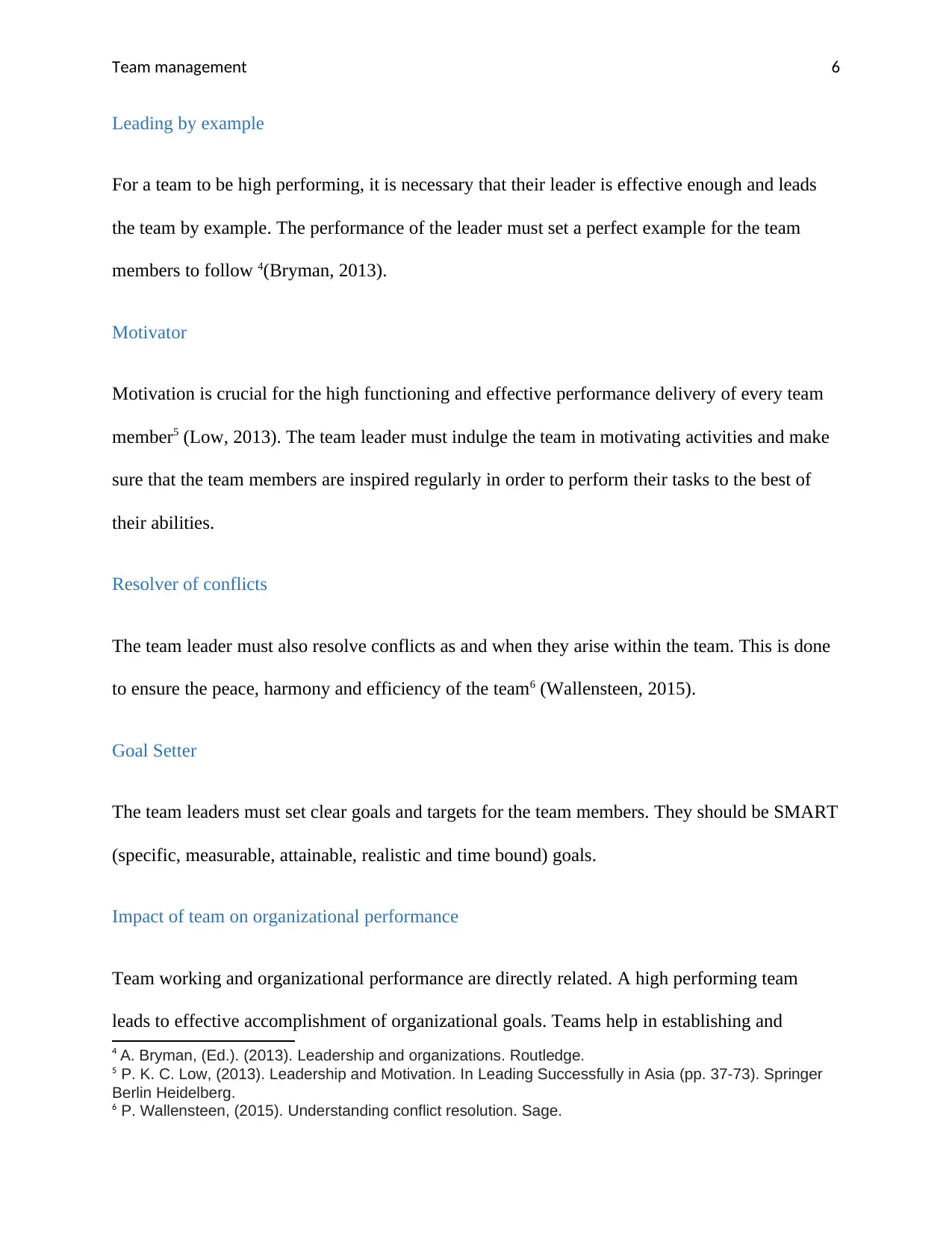
Team management 6
Leading by example
For a team to be high performing, it is necessary that their leader is effective enough and leads
the team by example. The performance of the leader must set a perfect example for the team
members to follow 4(Bryman, 2013).
Motivator
Motivation is crucial for the high functioning and effective performance delivery of every team
member5 (Low, 2013). The team leader must indulge the team in motivating activities and make
sure that the team members are inspired regularly in order to perform their tasks to the best of
their abilities.
Resolver of conflicts
The team leader must also resolve conflicts as and when they arise within the team. This is done
to ensure the peace, harmony and efficiency of the team6 (Wallensteen, 2015).
Goal Setter
The team leaders must set clear goals and targets for the team members. They should be SMART
(specific, measurable, attainable, realistic and time bound) goals.
Impact of team on organizational performance
Team working and organizational performance are directly related. A high performing team
leads to effective accomplishment of organizational goals. Teams help in establishing and
4 A. Bryman, (Ed.). (2013). Leadership and organizations. Routledge.
5 P. K. C. Low, (2013). Leadership and Motivation. In Leading Successfully in Asia (pp. 37-73). Springer
Berlin Heidelberg.
6 P. Wallensteen, (2015). Understanding conflict resolution. Sage.
Leading by example
For a team to be high performing, it is necessary that their leader is effective enough and leads
the team by example. The performance of the leader must set a perfect example for the team
members to follow 4(Bryman, 2013).
Motivator
Motivation is crucial for the high functioning and effective performance delivery of every team
member5 (Low, 2013). The team leader must indulge the team in motivating activities and make
sure that the team members are inspired regularly in order to perform their tasks to the best of
their abilities.
Resolver of conflicts
The team leader must also resolve conflicts as and when they arise within the team. This is done
to ensure the peace, harmony and efficiency of the team6 (Wallensteen, 2015).
Goal Setter
The team leaders must set clear goals and targets for the team members. They should be SMART
(specific, measurable, attainable, realistic and time bound) goals.
Impact of team on organizational performance
Team working and organizational performance are directly related. A high performing team
leads to effective accomplishment of organizational goals. Teams help in establishing and
4 A. Bryman, (Ed.). (2013). Leadership and organizations. Routledge.
5 P. K. C. Low, (2013). Leadership and Motivation. In Leading Successfully in Asia (pp. 37-73). Springer
Berlin Heidelberg.
6 P. Wallensteen, (2015). Understanding conflict resolution. Sage.
Paraphrase This Document
Need a fresh take? Get an instant paraphrase of this document with our AI Paraphraser
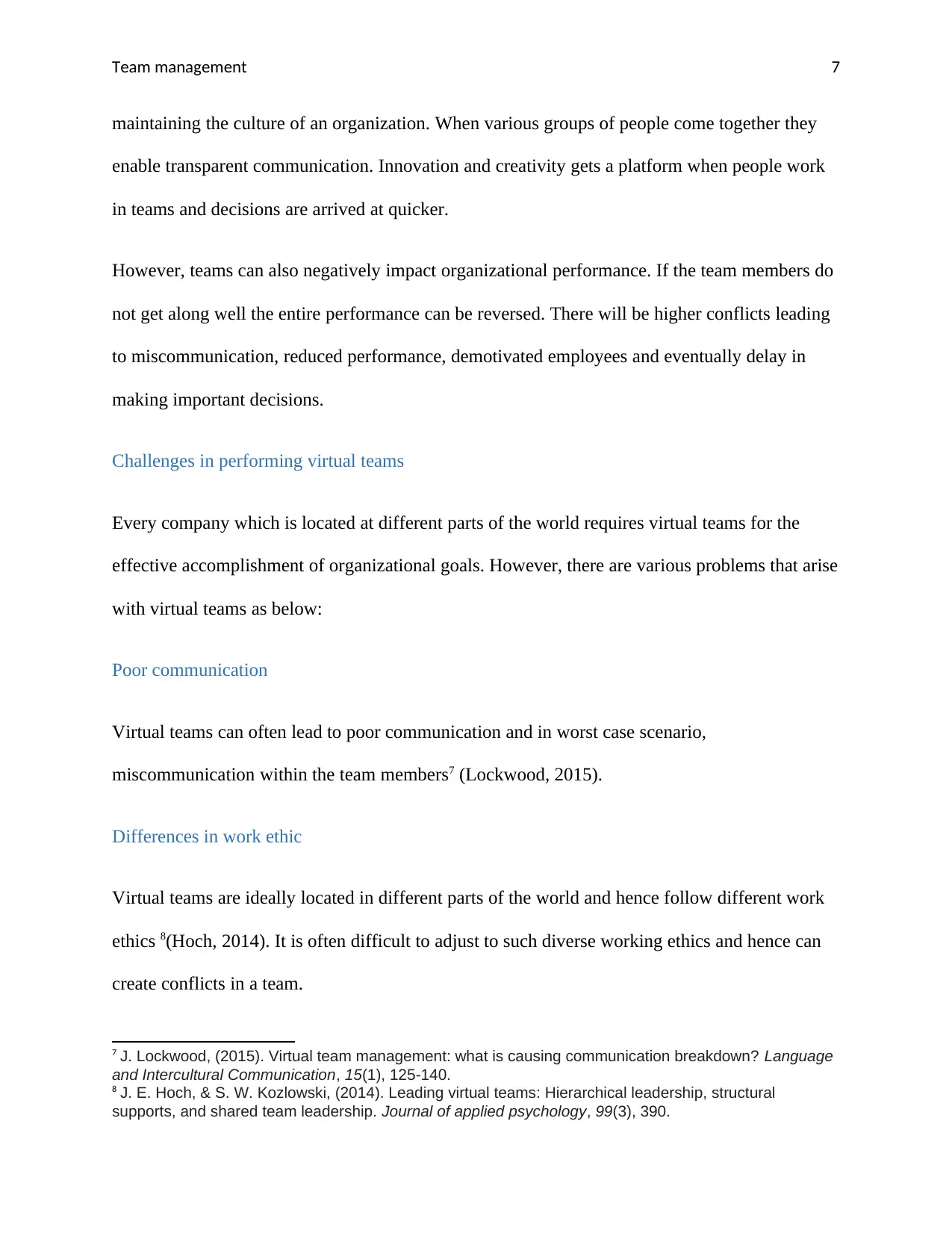
Team management 7
maintaining the culture of an organization. When various groups of people come together they
enable transparent communication. Innovation and creativity gets a platform when people work
in teams and decisions are arrived at quicker.
However, teams can also negatively impact organizational performance. If the team members do
not get along well the entire performance can be reversed. There will be higher conflicts leading
to miscommunication, reduced performance, demotivated employees and eventually delay in
making important decisions.
Challenges in performing virtual teams
Every company which is located at different parts of the world requires virtual teams for the
effective accomplishment of organizational goals. However, there are various problems that arise
with virtual teams as below:
Poor communication
Virtual teams can often lead to poor communication and in worst case scenario,
miscommunication within the team members7 (Lockwood, 2015).
Differences in work ethic
Virtual teams are ideally located in different parts of the world and hence follow different work
ethics 8(Hoch, 2014). It is often difficult to adjust to such diverse working ethics and hence can
create conflicts in a team.
7 J. Lockwood, (2015). Virtual team management: what is causing communication breakdown? Language
and Intercultural Communication, 15(1), 125-140.
8 J. E. Hoch, & S. W. Kozlowski, (2014). Leading virtual teams: Hierarchical leadership, structural
supports, and shared team leadership. Journal of applied psychology, 99(3), 390.
maintaining the culture of an organization. When various groups of people come together they
enable transparent communication. Innovation and creativity gets a platform when people work
in teams and decisions are arrived at quicker.
However, teams can also negatively impact organizational performance. If the team members do
not get along well the entire performance can be reversed. There will be higher conflicts leading
to miscommunication, reduced performance, demotivated employees and eventually delay in
making important decisions.
Challenges in performing virtual teams
Every company which is located at different parts of the world requires virtual teams for the
effective accomplishment of organizational goals. However, there are various problems that arise
with virtual teams as below:
Poor communication
Virtual teams can often lead to poor communication and in worst case scenario,
miscommunication within the team members7 (Lockwood, 2015).
Differences in work ethic
Virtual teams are ideally located in different parts of the world and hence follow different work
ethics 8(Hoch, 2014). It is often difficult to adjust to such diverse working ethics and hence can
create conflicts in a team.
7 J. Lockwood, (2015). Virtual team management: what is causing communication breakdown? Language
and Intercultural Communication, 15(1), 125-140.
8 J. E. Hoch, & S. W. Kozlowski, (2014). Leading virtual teams: Hierarchical leadership, structural
supports, and shared team leadership. Journal of applied psychology, 99(3), 390.
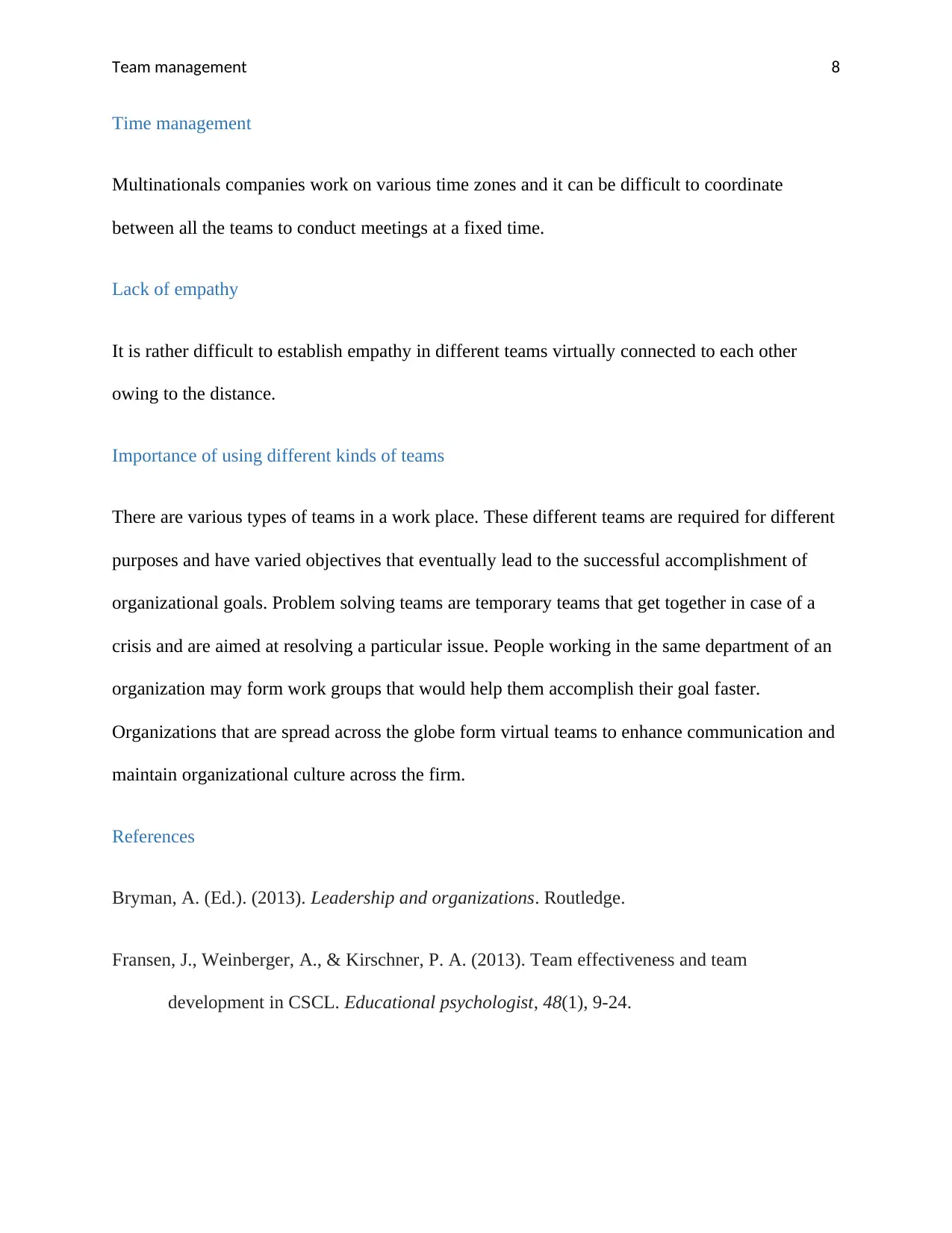
Team management 8
Time management
Multinationals companies work on various time zones and it can be difficult to coordinate
between all the teams to conduct meetings at a fixed time.
Lack of empathy
It is rather difficult to establish empathy in different teams virtually connected to each other
owing to the distance.
Importance of using different kinds of teams
There are various types of teams in a work place. These different teams are required for different
purposes and have varied objectives that eventually lead to the successful accomplishment of
organizational goals. Problem solving teams are temporary teams that get together in case of a
crisis and are aimed at resolving a particular issue. People working in the same department of an
organization may form work groups that would help them accomplish their goal faster.
Organizations that are spread across the globe form virtual teams to enhance communication and
maintain organizational culture across the firm.
References
Bryman, A. (Ed.). (2013). Leadership and organizations. Routledge.
Fransen, J., Weinberger, A., & Kirschner, P. A. (2013). Team effectiveness and team
development in CSCL. Educational psychologist, 48(1), 9-24.
Time management
Multinationals companies work on various time zones and it can be difficult to coordinate
between all the teams to conduct meetings at a fixed time.
Lack of empathy
It is rather difficult to establish empathy in different teams virtually connected to each other
owing to the distance.
Importance of using different kinds of teams
There are various types of teams in a work place. These different teams are required for different
purposes and have varied objectives that eventually lead to the successful accomplishment of
organizational goals. Problem solving teams are temporary teams that get together in case of a
crisis and are aimed at resolving a particular issue. People working in the same department of an
organization may form work groups that would help them accomplish their goal faster.
Organizations that are spread across the globe form virtual teams to enhance communication and
maintain organizational culture across the firm.
References
Bryman, A. (Ed.). (2013). Leadership and organizations. Routledge.
Fransen, J., Weinberger, A., & Kirschner, P. A. (2013). Team effectiveness and team
development in CSCL. Educational psychologist, 48(1), 9-24.
⊘ This is a preview!⊘
Do you want full access?
Subscribe today to unlock all pages.

Trusted by 1+ million students worldwide
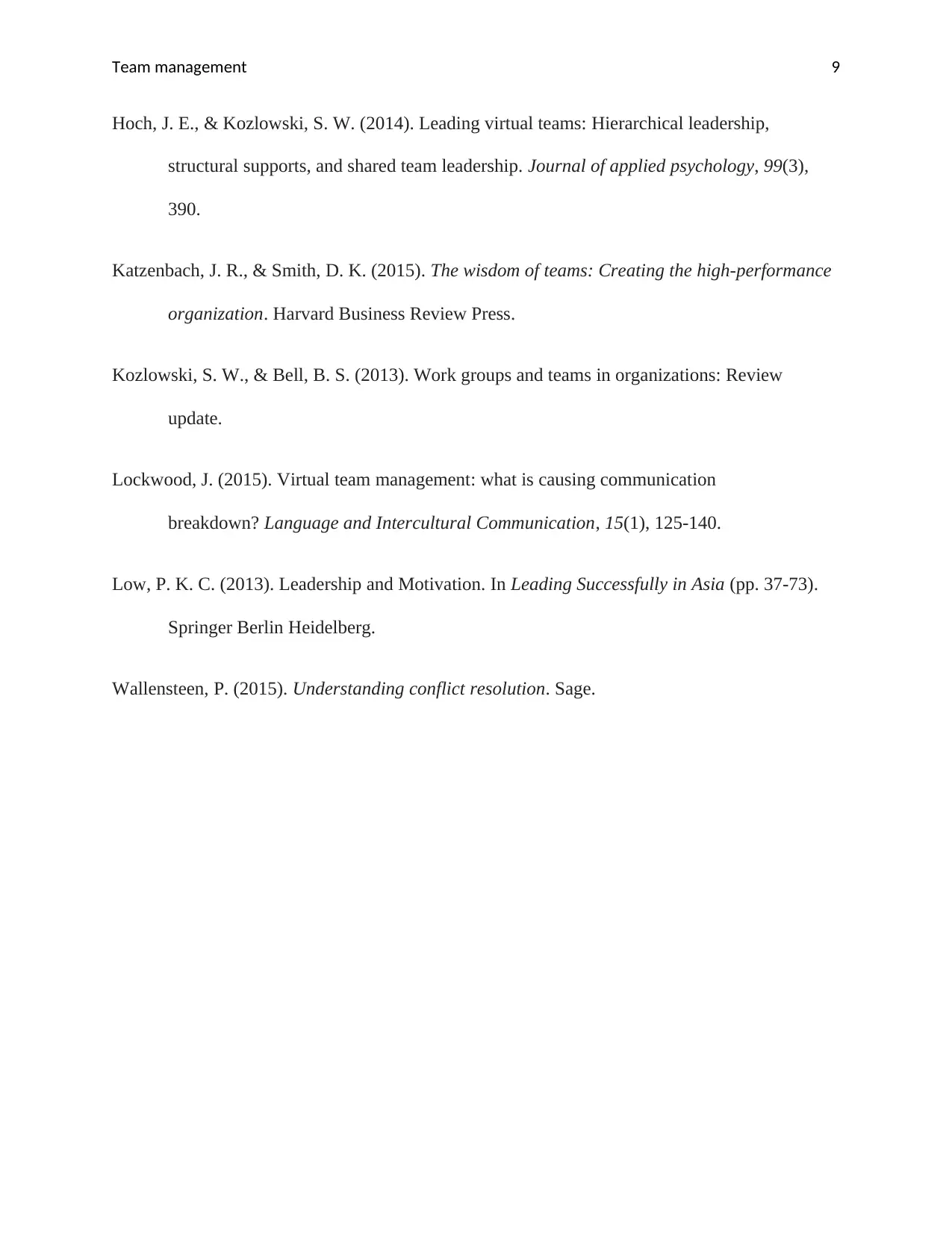
Team management 9
Hoch, J. E., & Kozlowski, S. W. (2014). Leading virtual teams: Hierarchical leadership,
structural supports, and shared team leadership. Journal of applied psychology, 99(3),
390.
Katzenbach, J. R., & Smith, D. K. (2015). The wisdom of teams: Creating the high-performance
organization. Harvard Business Review Press.
Kozlowski, S. W., & Bell, B. S. (2013). Work groups and teams in organizations: Review
update.
Lockwood, J. (2015). Virtual team management: what is causing communication
breakdown? Language and Intercultural Communication, 15(1), 125-140.
Low, P. K. C. (2013). Leadership and Motivation. In Leading Successfully in Asia (pp. 37-73).
Springer Berlin Heidelberg.
Wallensteen, P. (2015). Understanding conflict resolution. Sage.
Hoch, J. E., & Kozlowski, S. W. (2014). Leading virtual teams: Hierarchical leadership,
structural supports, and shared team leadership. Journal of applied psychology, 99(3),
390.
Katzenbach, J. R., & Smith, D. K. (2015). The wisdom of teams: Creating the high-performance
organization. Harvard Business Review Press.
Kozlowski, S. W., & Bell, B. S. (2013). Work groups and teams in organizations: Review
update.
Lockwood, J. (2015). Virtual team management: what is causing communication
breakdown? Language and Intercultural Communication, 15(1), 125-140.
Low, P. K. C. (2013). Leadership and Motivation. In Leading Successfully in Asia (pp. 37-73).
Springer Berlin Heidelberg.
Wallensteen, P. (2015). Understanding conflict resolution. Sage.
1 out of 10
Related Documents
Your All-in-One AI-Powered Toolkit for Academic Success.
+13062052269
info@desklib.com
Available 24*7 on WhatsApp / Email
![[object Object]](/_next/static/media/star-bottom.7253800d.svg)
Unlock your academic potential
Copyright © 2020–2025 A2Z Services. All Rights Reserved. Developed and managed by ZUCOL.




